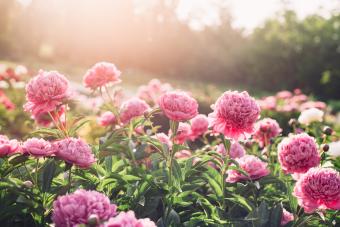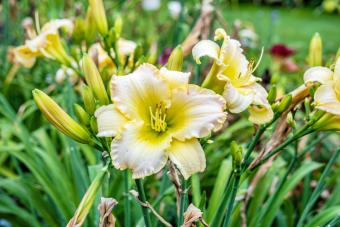
We love it when the first blooms of spring begin to appear, reassuring us that warm weather is just around the corner. It's like a little reward for making it through the stark, dark winter months. Some of our favorite first blooms of spring include the sunny daffodils, delicate snowdrops, and pretty crocus followed soon by fragrant hyacinths, vivid tulips, and others.
If you want your garden to greet you with bright colors and promises of warm weather, you can easily plant flowers for spring blooms. You'll plant many of these as fall bulbs before the first frost. With proper planting, a flower garden of any size can bloom victoriously in the spring.
Candytuft

Candytuft (Iberis sempervirens) is hardy in zones 4 through 9. It loves to soak up the full sun, but it will also thrive in partial shade, albeit with fewer flowers. The pure white blooms produce a stark contrast against the dark green foliage, but as the blooms age, they take on a pinkish or lavender hue. Candytuft grows to a height of about ten inches tall.
Bleeding Heart

We adore these sweet flowers that drip from a long, delicate stem. Bleeding heart (Lamprocapnos spectabilis) is hardy in zones 5 through 9. These beautiful flowers prefer partial shade, so they're perfect for placing in front of shrubs that don't go all the way to the ground.
They can grow to a height of almost three feet tall, depending on the particular cultivar. Work compost into the soil before planting bleeding heart in fall or early spring.
For gardeners living in colder climates, Luxuriant (D. Formosa) is hardy to zone 3.
Crocus

We always know that winter is in its last gasp when we see intrepid shoots of crocus poking up from the frosty ground, and we're always so glad to see them!
The crocus (Crocus vernus) is hardy in zones 3 through 8. These flowers bloom approximately two to three weeks after the winter crocus appear. They come in a variety of colors and include a few striped varieties. Crocus prefers gritty, well-draining soil — avoid heavy clay and super moist soil.
Related: Crocus Flower Care and Growing Tips
Tulips

Nothing says spring is here more than vibrant tulips. With their vivid colors and long, graceful stems, tulips are definitely one of our favorite spring flowers.
Tulips (Tulipa) are hardy in zones 3 through 8. They come in a wide range of colors and cultivars sure to suit any spring garden. The earliest varieties that bloom in spring include the Emperor (Fosteriana) and Single Early, which are the solid-colored, single flowers. Many of the early blooming varieties are between four and ten inches tall.
Hyacinths

Is there anything better than stepping outdoors in the early spring and catching a whiff of the heady scent of hyacinths waking from their winter naps? They're worth planting just for their aroma, but hyacinths are also a pretty, colorful addition to any spring garden.
Hyacinths (Hyacinthus orientalis) are hardy in zones 3 through 7. Most varieties of hyacinth grow up to 12 inches tall, and the waxy, densely packed blossoms come in shades of orange, peach, salmon, yellow, white, red, pink, purple, lavender, and blue. The double varieties require staking to prevent them from toppling over.
African Lily

The African lily (Agapanthus africanus) is hardy in zones 7 through 11. These flowers can reach a height of four feet, and their blooms can reach up to eight inches across. African lilies are great for rockeries, mixed borders, and flower beds.
If you plant African lilies from seeds, it will take 3 to 5 years for the plants to produce the first flowers.
Peonies

We love the cottagecore vibes of abundant spring blossoms, and nothing leans into this vibe more than peonies. These lush blossoms stand out among the glossy leaves of the shrubs where they grow, and they have a light, sweet aroma that will perfume your garden.
Peonies (Paeonia) are hardy in zones 3 through 8, although some gardeners have also had success with them in zones 2 and 9. They prefer full sun. There are many colors and cultivars to choose from, including peony trees. Peonies are drought-resistant spring flowers, and they will do well in almost any soil as long as it drains well.
Daffodils

Even before the sun fully shines in the spring, daffodils cast a sunny glow in our gardens. Daffodils (Narcissus pseudonarcissus) are hardy in zones 3 through 9. Blooms range in color from gold to lemon yellow to snowy white.
Most daffodil bulbs are very tolerant of cold weather; cold temperatures are actually necessary for the formation of the flower buds. For this reason, daffodils can't be grown in frost-free regions.
Cherry Blossoms

Nothing says spring quite as much as the splendor of delicate cherry blossoms dripping gracefully from tree branches.
Cherry blossoms (Prunus serrulata) on Oriental Yoshino cherry trees tolerate growing zones 5 through 8. The delicate blossoms of Yoshino and Kwanzan cherry trees (zones 5 through 9) are a lovely sight in the spring and are a beautiful addition to any list of flowering plants for spring. Cherry trees thrive in full sun exposure and deep, fertile soil with good drainage.
Pansies

With their cute little flower faces, pansies (Viola wittrockiana) are abundant as soon as the weather starts to warm. These delicate flowers are hardy in zones 4 through 8. Available in a wide range of colors, pansies are versatile flowers that you can grow in containers, in borders, or as ground cover. Pansies grow about 6 to 9 inches tall and thrive in moist, humus-rich, well-draining soil. Plant seeds indoors 6 to 8 weeks before transplanting outdoors.
Snowdrop Anemone

As spring progresses, snowdrop anemones open their faces to the sun. Snowdrop anemone (Anemone sylvestris) is hardy in zones 2 through 9. These delicate white flowers appear in late spring and early summer. Anemone flowers grow in dense patches with low mounds of ferny foliage, making them great for ground cover and borders. The plants are also deer and rabbit resistant.
Lilacs

Another flower that brings gorgeous cottagecore vibes, lilacs are delicate and old-fashioned with a sweet, heady fragrance. Lilac shrubs (Syringa vulgaris) are hardy in zones 3 through 7. The fragrant purple blooms appear in late May in most northern states. Depending on the variety, they grow from 5 to 15 feet tall. Plant lilac shrubs in areas where they will get at least six hours of sun per day; otherwise, they won't bloom well.
Harmony Iris

We love the vibrant blue and purple colors in harmony iris (Reticulata), also known as dwarf iris. This flower is hardy in zones 5 through 9. Harmony iris blooms very early in the spring. The very large blossoms have a wonderful fragrance similar to a violet, and they continue to come back year after year.
Icelandic Poppies

There's just something dreamy about a patch of colorful, delicate poppies. Icelandic poppies (Papaver nudicaule) are hardy in zones 2 through 8. Their brilliantly colored blooms start showing in late spring, around May, and thriving plants will continue to bloom through July. Colors range from orange, yellow, red, and white. Deadheading, or removing faded and dead blooms, helps encourage additional blooming.
Lily-of-the-Valley

Lily-of-the-valley (Convallaria majalis) is hardy in zones 3 through 7. The delicate white flowers produce a fragrant, sweet aroma synonymous with spring. Fresh clippings of the petite, bell-shaped flowers are perfect for small, sweetly scented bedside bouquets. The plants thrive in partial shade and can be an aggressive ground cover.
Sign up for our newsletter featuring all the latest stories and products we love.
Wisteria

With silvery violet drooping clusters of flowers that hang from a climbing vine, wisteria is a totally romantic spring flower. Wisteria (Wisteria sinesis) is hardy in zones 3 through 9. This vigorously blooming Asian vine produces showy, cascading flower clusters perfect for providing floral drapery and camouflage over outdoor trellises, covered porches, and pergolas.
Use caution with wisteria. It's toxic to dogs, cats, and horses and must be regularly pruned to keep it under control.
Rhododendron

We love how easy to care for and showy rhododendrons are — filling large swaths of landscape with colorful blossoms in the spring.
Rhododendrons (Rhododendron ferrugineum) are hardy in zones 4 through 9. Like azaleas, rhododendrons are regarded as one of the best flowering evergreen plants for temperate landscapes. Rhododendrons are characterized by large, shiny, leathery evergreen leaves and clusters of large pink, white, or purplish flowers that bloom from spring to early summer. The shrubs need to be watered if rainfall is less than 1 inch per week, and they grow to a variety of sizes, from one or two feet to over 20 feet tall.
Sweet Pea

Another cottagey vining flower, sweet peas are delicate and colorful with a heavenly aroma. Sweet pea (Lathyrus odoratus) is hardy in zones 2 through 11, although it thrives in cooler climates. This bushy, climbing annual features highly fragrant flowers in colors of purple, lavender, pink, red, blue, white, and bicolor. Sweet peas love full sunlight with their roots deep in cool, moist soil. Plant low-growing annuals in front of them to help shade their roots.
Roses

It's hard to imagine spring and summer without majestic, fragrant roses. Roses (Rosas) can be grown in any U.S. climate zone. Speak with a local nursery to find out which particular variety performs best in your climate. Then, choose the type of rose bush best suited to your garden or flower bed site.
Climbers and ramblers grow from 7 to 30 feet in length and need some type of support. Hybrid teas have large, single blooms on long, stiff stems, while floribundas have smaller clusters of blooms, and each of them grow to about 2 to 3 feet high. Roses come in thousands of varieties in multiple shades of red, pink, lavender, orange, yellow, white, and two-tone colors.
Muscari

Muscari (Muscari armeniacum), commonly known as grape hyacinth, is hardy in zones 4 through 8. These showy, royal blue April bloomers are easy to grow in average well-drained soil in full sun or partial shade. Keep them thriving with moist ground during the spring growing season. When you notice the foliage starting to die back, you can reduce watering as the plants go dormant during the summer.
Celebrate Spring Flowers

Celebrate spring with a garden of vibrant blossoms. With a little planning, your garden can burst with color as soon as winter frost fades.







